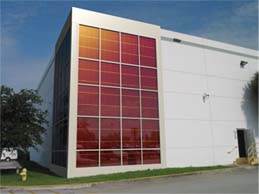Konarka markets building-integrated solar
 Konarka Technologies sees a different future for its remarkably adaptable solar product than solar companies have traditionally pursued in the past.
Konarka Technologies sees a different future for its remarkably adaptable solar product than solar companies have traditionally pursued in the past.
“I’ve been in the solar industry a long time,” said Ken McCauley, Konarka’s senior vice president of sales, marketing and business development. “And this is really a different product. I tend not to think of it so much as solar as an advanced building material.”
While Konarka’s building-integrated photovoltaic technology does use the sun’s energy to produce electricity, the material is mutable. It’s not a flat black panel affixed to a roof. It can come in a variety of sizes and colors and it can be formed into any shape on Earth, McCauley said.
“And you can see through it,” he added.
That means the material can even be applied to glass surfaces like office windows.
Konarka announced this week it’s new partnership with Dri-Design, which started integrating Konarka’s solar technology into its metal rainscreen panels.
McCauley said that marketing this product is different from marketing any other solar product. He’s not presenting it at solar and renewable energy conferences much and he’s not pitching it to homeowners.
Konarka will have a display project at the American Institute of Architects conference this week.
While the product needs significantly more area to produce the same amount of power as traditional solar, it’s lighter and more flexible and more versatile. Instead of asking about efficiency percentages, architects ask about what colors it can come in and how it can be integrated into other materials.
“Our growth of the company is not dependent on the popularity of solar,” McCauley said. “For us to win, it doesn’t mean another solar company has to fail because what we offer is so different.”
Konarka is concentrating on finding new ways and places to integrate solar into building materials. It’s currently being used on some buildings, bus stations and iPad cases. The technology can even draw energy from indoor lighting, McCauley said.
He said he foresees a future when renewable energy is no longer a novelty and big solar installations don’t make news anymore because they will just be a way of life.
“We’re putting solar where it was not feasible to put solar before,” McCauley said.
Image courtesy of Konarka



